At the Members night on Thursday 7 December at 7.30pm three Committee Members gave brief talks on four forgotten Haddingtonians.
Nora Jenkinson
I met Nora Jenkinson on several occasions when I accompanied my father-in-law, who was her Elder at St Mary’s Church, to Harperdean Farm, just outside Haddington. They both enjoyed a lively debate about current affairs. I was aware that she ran an astronomy club, but I did not know any more about it at that time.
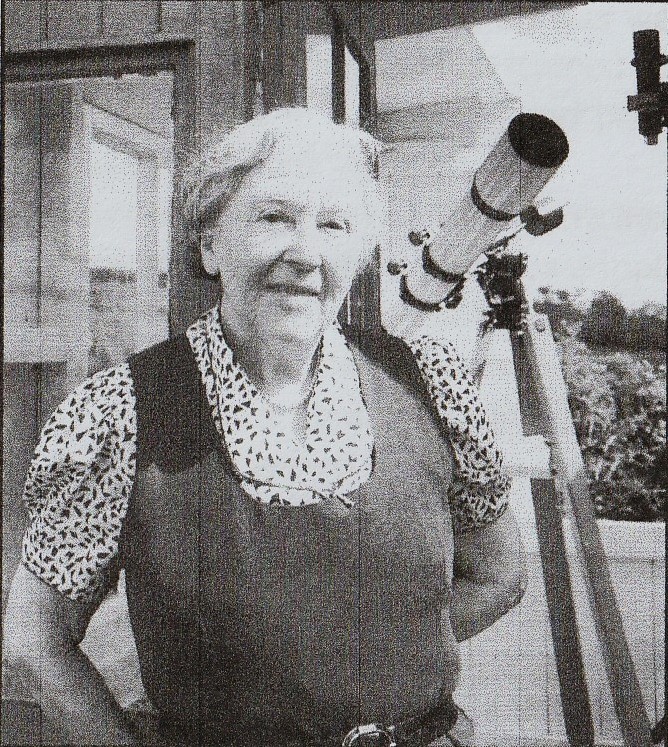
Nora and her husband William came to Harperdean in 1946 and she was busy with life on the farm and bringing up their two sons. When William died and their son Ian took over the running of the farm Nora was encouraged by her family to follow up her childhood interest in astronomy. She attended adult education classes at the University of Edinburgh and gained a Scottish Certificate of Education in Astronomy.
She bought her first telescope – a 4” refractor – with a legacy from a farm tenant that she had helped to care for in his old age and her second – a 14” Dobsonian reflector telescope – with a legacy from her brother. The slide of the planets shows the level of detail possible with such a telescope.
In 1974, from her observatory, only a few paces from her front door in her garden, she started a free Tuesday class in astronomy for local children. There could be up to 20 pupils in the Society, including Nora’s grandchildren, and they met every Tuesday come rain or shine missing only six Tuesdays in over 20 years. They gave talks, drew, watched videos, made models and built instruments including an 8½ inch reflector telescope. Several of Nora’s young people went on to take degrees in science and one became a professional astronomer in Teneriffe. Often, they continued to attend after moving on to higher education and jobs. Local astronomers would visit to give talks including members of the Edinburgh Astronomical Society.
In 1993 The Edinburgh Astronomical Society awarded Nora the Lorimer medal for her notable contribution to popular astronomy and made her an honorary member. She was one of only nine people to receive this award – previous recipients included the cosmologist Sir James Jeans, Patrick Moore and a couple of Astronomer Royals. A delegation from the Society visited Nora at Harperdean and the medal was presented by their president Dr John Reid in the presence of all the young members and family.
In 1997 Nora was astonished to receive a phone call from Siding Springs Observatory in New Zealand to tell her that an asteroid was to be named “The Nora Jenkinson Asteroid” in her honour. It had been discovered by an astronomer who had visited the group at Harperdean. She is reported to have said” why do I deserve this for something that I love doing – teaching children a love of stars”
Nora was active well into her nineties and died at the age of 97 in August 2005.
VH
Francis Farquharson (1805-1878): builder, architect, provost
Francis Farquharson was born at Auchterarder on Trafalgar Day, 1805 (October 1st). He served his time as a joiner. One of the first buildings we know he worked on was Moulin Kirk near Pitlochry. He moved to Haddington around 1832 to serve as clerk of works on the County Buildings and on Monkrigg House. The architect for both was William Burn.
In 1840 he took over the business of a master mason, Frank Balsillie, who was killed when thrown from his horse. In 1853 he bought Hilton Lodge where he lived for the rest of his life. He designed and built Haddington Corn Exchange (1853/54). He built farm cottages at Papple in 1857-58 and between 1871 and 1874 designed and built the large steading there as well as farm cottages and improvements to the farmhouse. The work was extensive, requiring new access roads and dykes. The new tenant complained about the damage to the fields caused by heavy waggons and that he had nowhere to house his cattle until the work was complete. His cash rent was written off for the first year.

Farquharson in his own words “hated anything cheap and nasty”. The farmhouse was fitted with marble jambs for the fireplaces and hanging bells. His professional fees for Papple amounted in today’s money to £208,000. This excludes the actual building costs which ran into millions.
He served as Provost from 1863 to 1867. He advocated drainage and was in favour of the ‘gravitational scheme’. Until 1874 most of the town depended on public wells: two in the High Street and two in Hardgate. Cossar’s well supplied part of the Nungate. Many larger houses had their own wells. The town was divided on the issue of wells versus reservoir. ‘Gravitationists’ were those who supported a reservoir. This was achieved in 1874 with a supply from Chesters.
He died on 16th December 1878. His obituary was carried by the Courier on 20th December 1878 – one of the sources for this account. Papple costs are included in the Whittingehame and Strathconan estates accounts NRS GD 433/1/21-23.
EHG
William Hugh Ewen (1879-1947): Musician, producer, aviator, entrepreneur
W.H.Ewen was born in 1879 in Shanghai where his parents were involved in mission work. He studied for a BA in Music at the University of Edinburgh and was employed as organist at the West Church, Haddington, ca 1901. He appears later to have served as organist and choir master at St Mary’s. His interest in music extended to light opera and in 1910 he founded W.H.Ewan’s Operatic Company which became Haddington Amateur Operatic Society.
He developed an interest in flying and was one of the first Scots to gain a flying certificate in 1911. For the test he piloted a Bleriot Monoplane. The test involved circuits, reaching a height of 150 feet and at a point cutting the engine to land as near as possible to a designated spot. He founded a flying school at Lanark offering lessons leading to the certificate at a cost of £75 with £15 returnable if there were no breakages (presumably to the plane rather than the pilot).
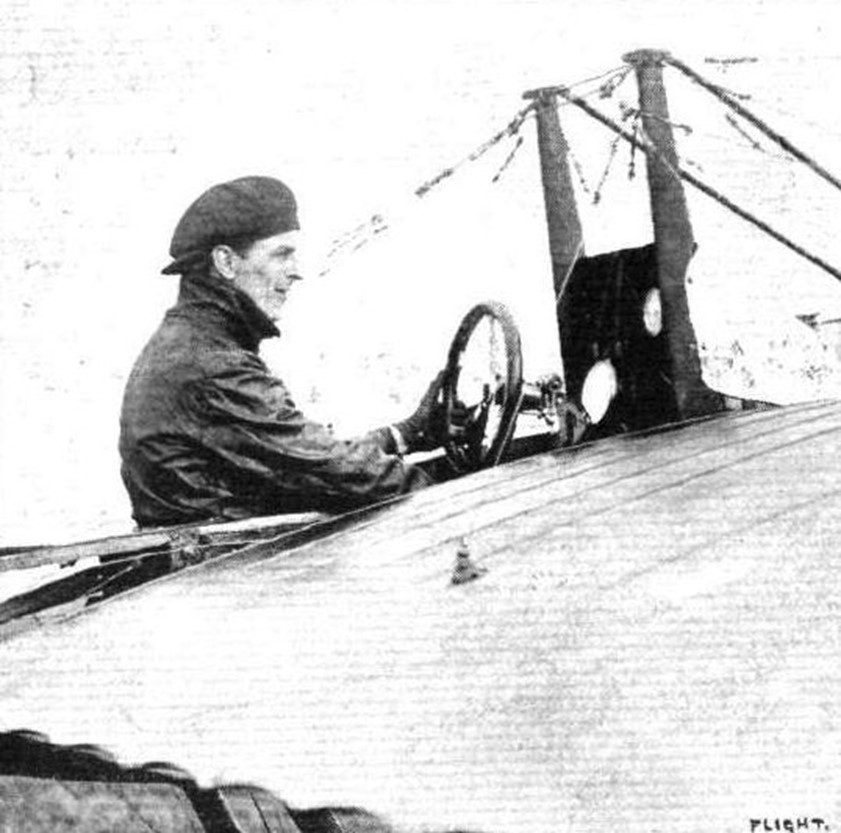
He seems to have been disappointed in the numbers enrolling. The Courier (17/05/1912) reports hims saying, “It’s rather odd that Scotsmen are not in a rush to fly. One feels that Scotsmen have just the temperament for flyers. They are usually cool, with presence of mind, and weigh up risks well.”
In 1911 he gave a flying display at the East Lothian show. Displays were a way of attracting crowds. His display was not a success. The Courier reports that he crash-landed on the north bank of the Tyne. The plane was retrieved in pieces. He had more success later that year (30th August) becoming the first Scotsman to cross the Forth in both directions, taking off from Portobello , flying over Inchkeith and turning near Kinghorn for the return journey.
In 1912 he moved to Hendon and set up a company in partnership with Caudron, a French manufacturer of aircraft. His company produced a range of Caudron aircraft, some of which were sold to the Royal Navy Air Service; there was no RFC or RAF at the time. His daredevil exploits continued. Taking part in a relay race at Hendon, flying low he crashed at 48 mph. “The machine turned right over, the tail going over the head and Ewen’s goggles smashing on his face, gashing his right cheek. He also injured his right knee but fortunately was wearing a pneumatic helmet which saved his head from serious injury” (Courier 31/05/1912). In July 1912 he and his mechanic were badly injured when his plane dropped 40 feet as he was leaving Peterborough for Lincoln (Courier, 05/07/1912). In spite of this, he continued to train pilots at Hendon with 350 trained by 1914.
A further account describes him taking a new Caudron model on a test flight to Harrow (about 7 miles). After half an hour he was lost and landed to ask two farm workers the way. One pointed one way and the other in a different direction. He landed again on a golf course where he was advised to follow a railway line. He did so and landed in failing light near Harrow where his mechanics awaited him with fuel. Rather than leave the plane in a field overnight, he instructed one of the mechanics to light matches as fast as he could to indicate the height of the hedge. He took off and made a oerfect landing at eight-thirty at Hendon, where flares had been set and rockets launched.
He gave up his business in 1914. He volunteered for the war effort in 1915 and served as a lieutenant in the ordnance department. He was commissioned as a major in the Royal Flying Corps which merged with the Royal Navy Air Service to form the Royal Air Force in 1918. He resigned his commission on the grounds of ill-health in October 1918.
His musical interests continued. In 1922 Boosey & Co. published the Zephyr Waltz by W.H. Ewen. He died in Musselburgh in 1947.
His grandson, John Richard Terry, gave a talk on his life at the Museum of Flight in 2009. His slides are on :
https://www.slideshare.net/magickpyggie/william-hugh-ewen-scottish-aviation-pioneer from which much of this account is drawn.
EHG
Doris Ann Goodchild 1906-1999
Artist and illustrator, writer and diarist, Doris Ann Goodchild was not a native of Haddington but adopted the burgh as her home. Born in London 1906, the middle child of seven, she lived and worked in England for over 60 years. She studied art and latterly taught art at teacher training college where she met her lifelong companion, Margaret Burnett, a science teacher. Margaret, who was born in Haddington and had relatives here, introduced Doris to the glories of East Lothian. Because this ‘lover of beauty’ as Doris described herself, fell in love with the county, they chose to retire here.
Over next 35 years Doris enjoyed a new career or, as she called it, a ‘voyage of creative discovery ‘, indulging her passion for art. The couple not only toured all over Scotland but travelled to Australia, Thailand and throughout Europe. With her keen artist’s eye for seeking out quaint places Doris recorded and illustrated them all in copious sketchbooks.
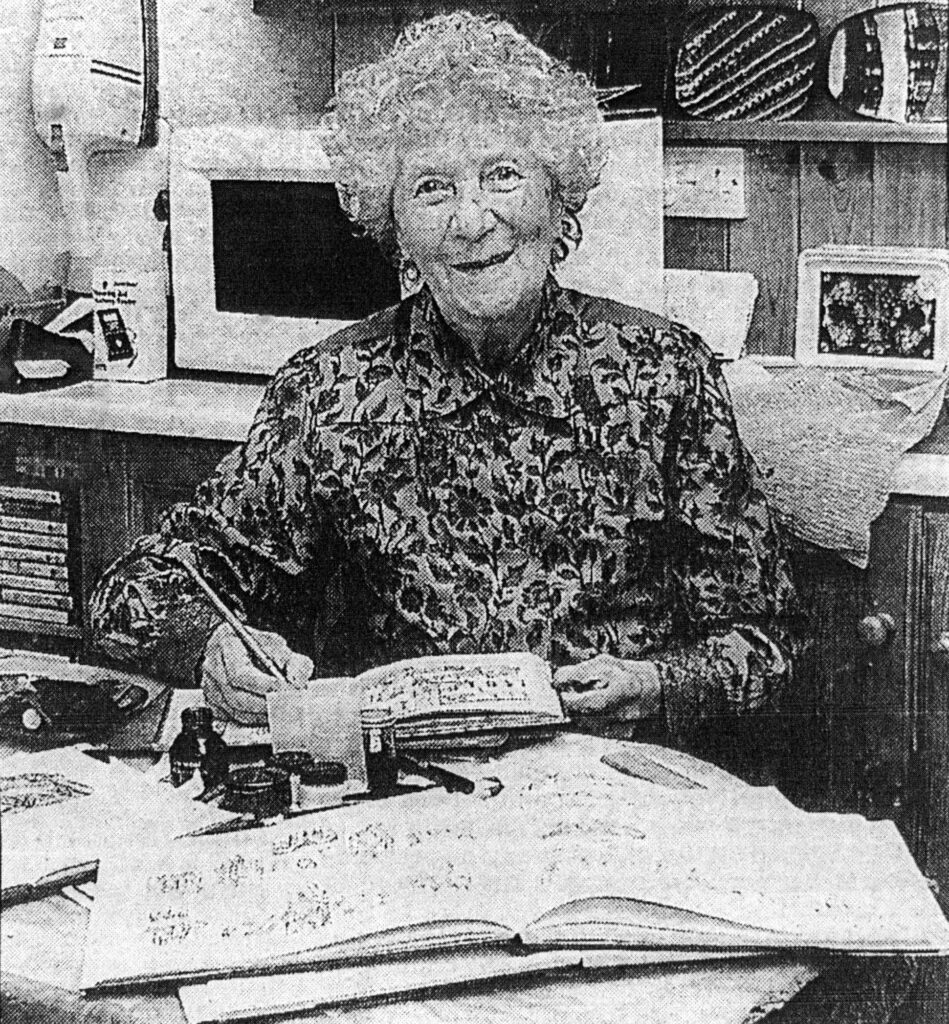
Back home she sketched almost every landmark in Haddington and Edinburgh, every cobble, every stone, every nook and cranny in the burgh and the capital city. Her numerous sketchbooks filled with drawings of the East Lothian coast, countryside, towns and villages are peppered with lines of poetry or couthie sayings and literary quotations. The detailed descriptions in her books make wonderful travel guides.
She published the first of twelve books, an illustrated guidebook to Edinburgh’s Royal Mile, at the age of 72. Her unique talent was recognised by Royal Incorporation of Architects in Scotland who awarded her an Honorary Fellowship for her Pen Portraits of Edinburgh. As well as sketching Doris painted in water colours and one of her paintings, White Californian Poppies, is held at the Royal Scottish Academy in Edinburgh.
Remarkably, in her 88th year, Doris sketched the gargoyles of St Mary’s Kirk, Haddington (see illustration Looking Skywards). Well happed against the wind, armed with binoculars and spectacles, sketch pad and biro, and regretting the loss of keen eyesight, she scrutinized the roof eaves and walls of the church for the intricate carvings. Sketching these gargoyles, she admitted to using artistic licence to fill in those images damaged beyond deciphering. She closely identified with, and greatly admired, the pre-reformation local craftsmen or itinerant artisans who made them but her contribution to our understanding of them is just as impressive.
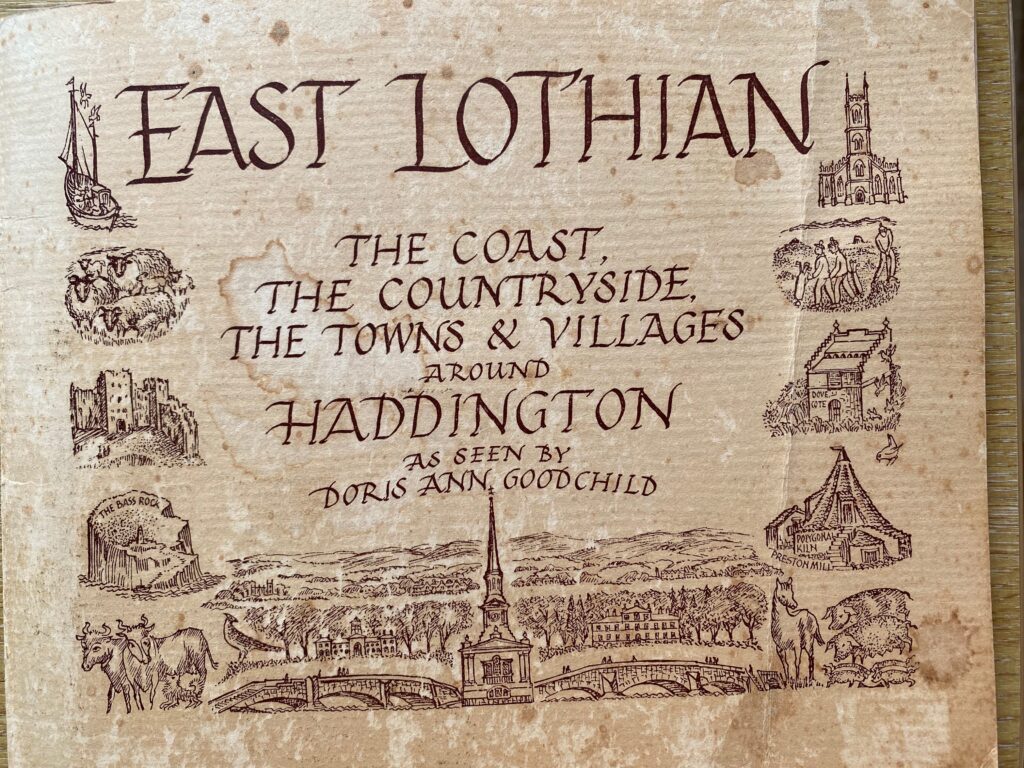
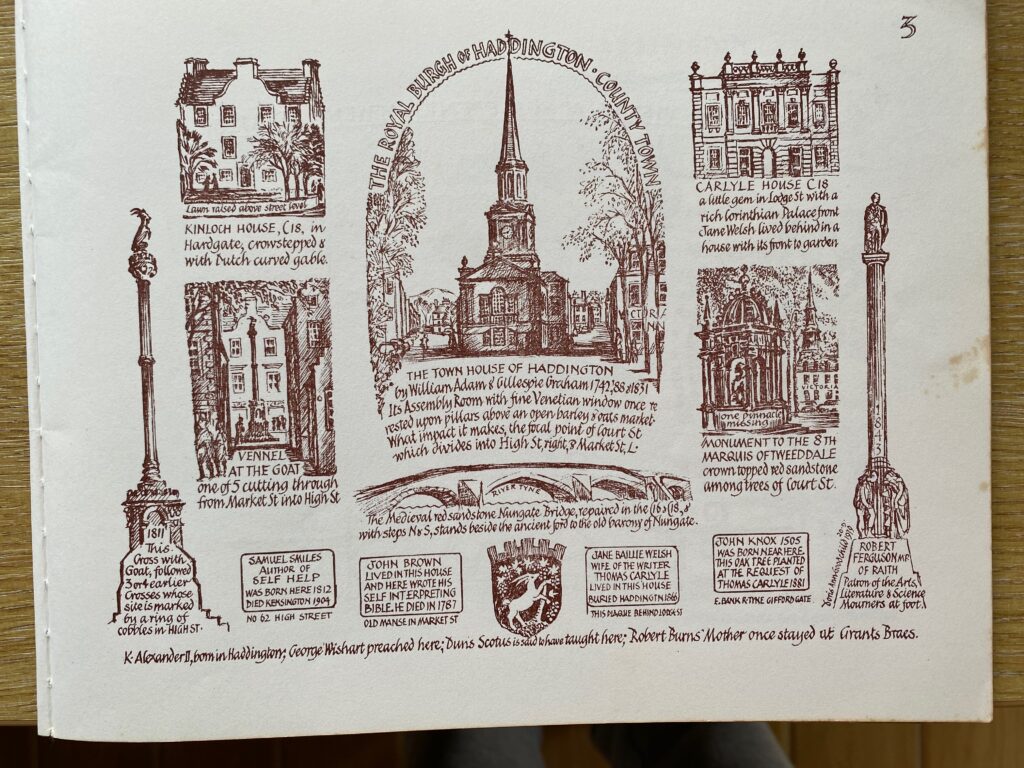

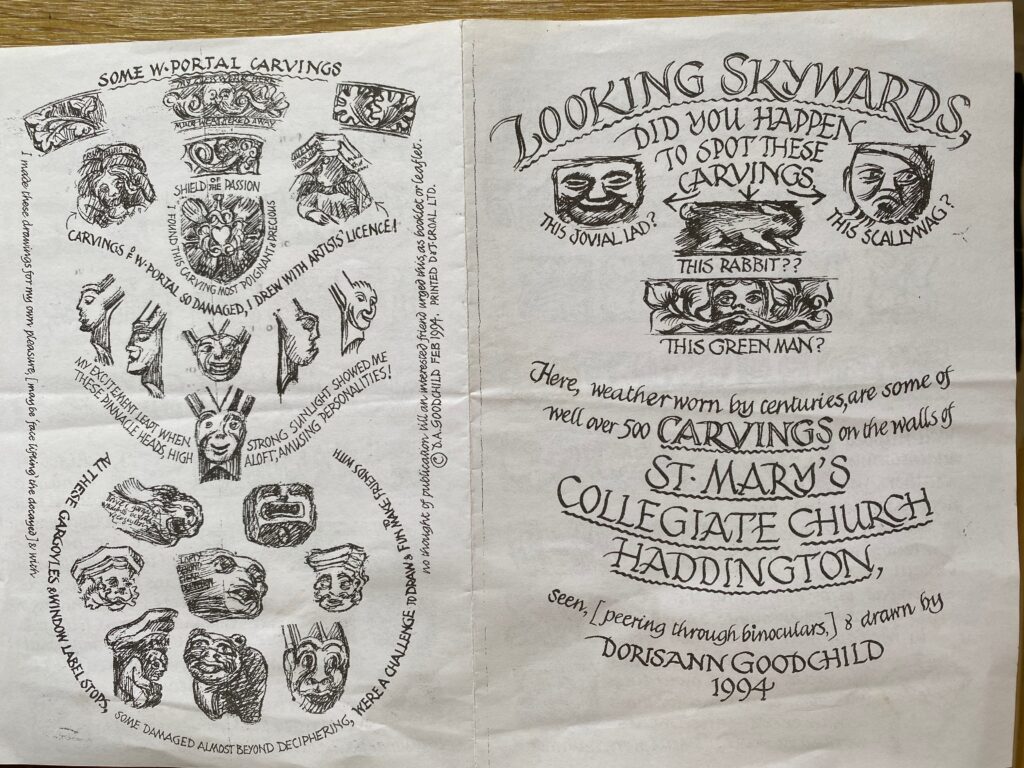

In the New Year’s Honours list of 1999, Doris was awarded an MBE for her services to art and education. Sadly she was not able to bask in its glory for long as she died 19 September 1999 aged 93.

The life of this talented lady who survived two World Wars and all the constraints of being a single woman pursing career in art spanned almost the whole of the 20th century. Indefatigable and indomitable she never stopped working and left us with this advice:
Retirement allows time not only to look but to inspect closely, to ponder on, to search out one’s new environment; to look upwards as well as down not only at the heaven’s embroidered cloths & filigree treetops but skylines broken by windvanes and those decorative topknots and enrichments in which the builders of old in more lavish periods used to indulge.
Selected publications:
- Goodchild, Doris Ann, The Royal Mile a Souvenir Guide (1978)
- Goodchild, Doris Ann, Hills of Edinburgh (1979)
- Goodchild, Doris Ann, Pen Portraits of Edinburgh (1981)
- Goodchild, Doris Ann, A Few Thoughts in Praise of Foods (1982)
- Goodchild, Doris Ann, Days in the Western Highlands and Islands (1982)
- Goodchild, Doris Ann, Glimpses of a Few Cities, Towns, Countrysides, at Home & Abroad: Some 700 Drawings & Diary (1984)
- Goodchild, Doris Ann, Travels In Scotland, England and Overseas (1986)
- Goodchild, Doris Ann, The Spoils of Time – Some Aspects of Living in this 20th Century (1988)
- Goodchild, Doris Ann, Diary Days in the 86th Year of Great Aunt Tit-Bit (1990)
- Goodchild, Doris Ann, Recollections & Reflections by Rail (1990)
- Goodchild, Doris Ann, Diary – How I spent my Ninetieth Birthday Weekend (1996)
References
A Millennium of Fame of East Lothian by David Dick, Clerkington Publishing Co, Haddington, 2000
Marie Macpherson 2023
You must be logged in to post a comment.